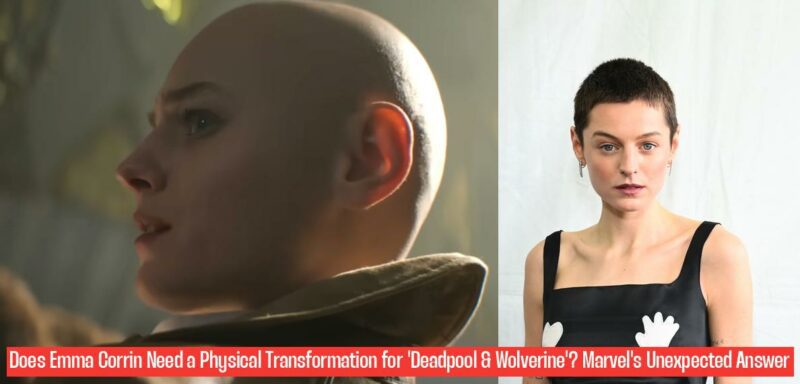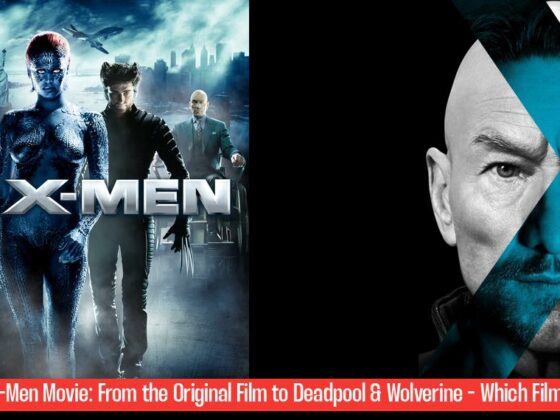Emma Corrin’s Transformation for ‘Deadpool & Wolverine’: A Story of Trust and Charm
The world of superhero movies is often synonymous with jaw-dropping physical transformations. From Chris Hemsworth’s Thor-worthy physique to Gal Gadot’s Amazonian grace, actors often undergo rigorous training and grueling diets to embody their iconic characters. But what happens when a studio says, “No, thanks, we don’t need that?” That’s exactly what happened to Emma Corrin, the talented actor known for their role as Princess Diana in “The Crown,” when they joined the cast of “Deadpool & Wolverine.”
Corrin, eager to dive headfirst into the world of supervillains, was prepared to undergo a major physical transformation. They envisioned a character, Cassandra, who would be physically imposing and threatening, mirroring the common trope of villainous characters in superhero movies. But when Corrin approached the production team with their vision, they were met with a surprising response. Director Shawn Levy and Ryan Reynolds, the star of “Deadpool,” didn’t want Cassandra to be physically threatening. Instead, they wanted her to be sinister in a charming, almost seductive way.
> Benedict Cumberbatch’s Involvement in Avengers 5: What We Know So Far
Corrin, who was initially disappointed by the lack of physical training, quickly realized the genius behind this decision. It wasn’t about muscle mass or brute strength; it was about an entirely different kind of power – the power of charisma, of manipulating people with a sly smile and a whispered threat. This shift in perspective allowed Corrin to explore a different kind of villainy, one that leans on intelligence and charm rather than physical dominance.
The Power of Trust: Redefining Villainy in ‘Deadpool & Wolverine’
The decision to forgo physical training for Corrin’s character in “Deadpool & Wolverine” was a bold one, and it speaks volumes about the trust that existed between the actor, the director, and the studio. It shows that Marvel, known for its meticulously crafted action sequences and physically impressive characters, is willing to take a chance on a different approach, embracing a more nuanced and intriguing villain.
This decision also reveals a deeper understanding of how power can be wielded. While brute force certainly has its place in the world of superheroes, there’s an undeniable allure to a villain who can manipulate and control people without lifting a finger. It adds a layer of complexity and intrigue to the narrative, making the villain a more formidable opponent.
Corrin’s character, Cassandra, embodies this concept perfectly. She is a powerful force not because of her physical prowess, but because of her sharp wit, her manipulative tendencies, and her ability to play people against each other. This approach to villainy allows Corrin to explore a different facet of the character, challenging the traditional notions of what it means to be “evil.”
Beyond Physicality: The Importance of Storytelling in Superhero Films
In the realm of superhero movies, physical transformation is often a key element, a visual representation of the character’s power and determination. But “Deadpool & Wolverine” takes a different path, demonstrating that storytelling is just as important as the spectacle. By focusing on the character’s personality, their motivations, and their unique brand of villainy, the film creates a more compelling and thought-provoking narrative.
Corrin’s portrayal of Cassandra is a testament to the power of storytelling. It shows that a character can be just as impactful, if not more so, through their intelligence, their charm, and their ability to manipulate situations to their advantage. It’s a reminder that superhero films are not just about punching and kicking; they are also about exploring the complexities of human nature, the motivations behind good and evil, and the power of a well-crafted story.
This shift in focus allows “Deadpool & Wolverine” to stand out from other superhero movies, offering a fresh perspective on the genre and challenging the conventional approach to villainy. It suggests that Marvel, known for its high-octane action and visually stunning sequences, is willing to embrace a more nuanced and thought-provoking narrative, proving that a compelling story can be just as powerful as a physical transformation.
Emma Corrin’s Journey: A Testament to Trust and Collaboration
Emma Corrin’s experience on “Deadpool & Wolverine” is a powerful reminder of the importance of trust and collaboration in filmmaking. By trusting the vision of the director and the studio, Corrin was able to explore a different path, one that pushed the boundaries of villainy and redefined the character of Cassandra. It’s a testament to the fact that sometimes, the most compelling stories are not about achieving the most impressive physical transformation, but about embracing the unique qualities of a character and allowing them to shine through.
Corrin’s journey also highlights the importance of being open to new possibilities, to challenging the norms and embracing the unexpected. By stepping outside the box of traditional villainy, Corrin created a character that is both intriguing and memorable, proving that a villain can be just as captivating through their charm and intelligence as through their brute strength.
The story of Emma Corrin’s transformation for “Deadpool & Wolverine” is a reminder that superhero movies are more than just spectacle and action. They are about exploring the complexities of human nature, the motivations behind good and evil, and the power of a well-crafted story.
The Future of Supervillains: A Shift in Perspective
In the wake of Corrin’s experience, one can’t help but wonder if this shift in perspective towards villainy is a sign of things to come. Will we see more superhero films that focus on the psychological and manipulative aspects of villainy, rather than just physical dominance? Will actors be challenged to explore the nuances of their characters, rather than just achieving the perfect physique?
The answer, of course, is uncertain. But Corrin’s journey on “Deadpool & Wolverine” offers a compelling glimpse into a future where superhero movies are not just about the spectacle, but also about the stories they tell, the characters they portray, and the complex world they create. It’s a future where villainy is redefined, where power is wielded not just through physical strength, but also through intelligence, charm, and manipulation.
This development would signify a significant shift in the superhero genre, one that would open up new possibilities for storytelling and character development. It would allow filmmakers to explore the depths of human nature, to challenge the traditional notions of good and evil, and to create characters that are both intriguing and unforgettable.
Emma Corrin’s experience on “Deadpool & Wolverine” is a testament to the power of embracing the unexpected, of trusting the creative process, and of challenging the norms. It’s a story that reminds us that superhero movies can be more than just explosions and action sequences; they can be vehicles for exploring complex themes, for creating memorable characters, and for telling stories that stay with us long after the credits roll.
What was Emma Corrin’s initial vision for their character in “Deadpool & Wolverine”?
Emma Corrin envisioned a physically imposing and threatening character named Cassandra, mirroring the common trope of villainous characters in superhero movies.
How did the production team, including director Shawn Levy and Ryan Reynolds, respond to Emma Corrin’s vision?
The production team wanted Cassandra to be sinister in a charming, almost seductive way, rather than physically threatening.
What did Emma Corrin realize about the decision to forgo physical training for their character?
Emma Corrin realized that the decision was about exploring a different kind of villainy, one that leans on intelligence and charm rather than physical dominance.
What does the decision to redefine villainy in “Deadpool & Wolverine” reveal about Marvel and the trust between the actor, director, and studio?
The decision shows Marvel’s willingness to take a chance on a different approach, embracing a more nuanced and intriguing villain. It also highlights a deeper understanding of how power can be wielded beyond brute force.



